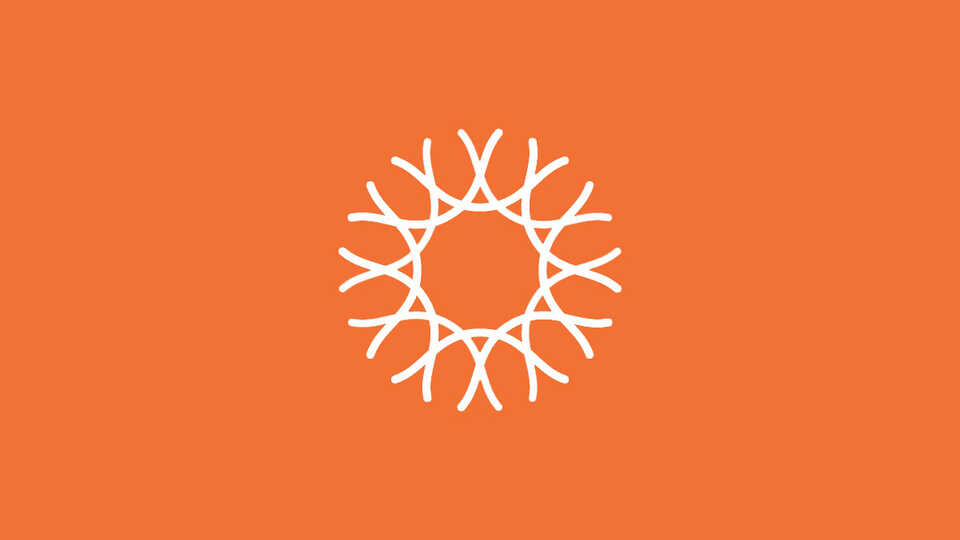
Yes, the title is a play on words, and given the great threat posed to the unexplored natural environments of these two little unique islands by future oil revenues, I suppose a more appropriate title would be “Matters of Urgency,” but I couldn’t help myself. In this posting I want to talk about the work of Dr. Richard Mooi, who was with us on GG II. 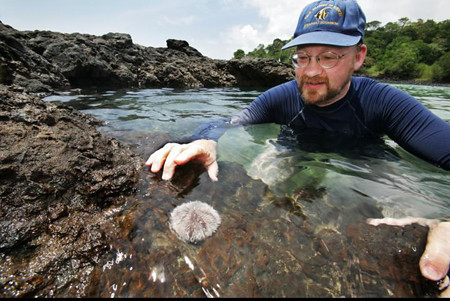 Rich stalks an unsuspecting sea urchin on São Tomé. D. Lin phot. GG II. Dr.Rich Mooi is a Curator in our Department of Invertebrate Zoology, but more importantly to us (and to the blog title!), he is one of the world’s authorities on echinoids, a large phylum that includes sea urchins, seas stars and what we Americans call “sand dollars,” the flat, disk-like tests (exoskeletons) of which we find commonly on our beaches. One of the most fascinating, yet poorest known sand dollars in the world is Rotula deciesdigitata, known only from the Gulf of Guinea. This species is probably not really rare but the places it occurs are remote and not frequently visited by scientists. Hence, they are super-scarce in the world’s natural history collections; even more so in North America.
Rich stalks an unsuspecting sea urchin on São Tomé. D. Lin phot. GG II. Dr.Rich Mooi is a Curator in our Department of Invertebrate Zoology, but more importantly to us (and to the blog title!), he is one of the world’s authorities on echinoids, a large phylum that includes sea urchins, seas stars and what we Americans call “sand dollars,” the flat, disk-like tests (exoskeletons) of which we find commonly on our beaches. One of the most fascinating, yet poorest known sand dollars in the world is Rotula deciesdigitata, known only from the Gulf of Guinea. This species is probably not really rare but the places it occurs are remote and not frequently visited by scientists. Hence, they are super-scarce in the world’s natural history collections; even more so in North America. 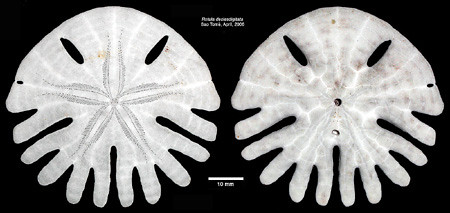 Technical photo. Rotula deciesdigitata. The unit of currency in the Republic of São Tomé and Prìncipe is the Dobra; there are about 15,000 of ‘em to the US dollar. Here is a photo of a bunch of dobras drying on my bed at Bom Bom Island on Principe. Why? Well, the wonderful folks at Bombom Island and SCD allowed us to attempt to survey by boat the otherwise inaccessible southwest shore of Prìncipe; at a critical point, too many of us climbed into a small red dinghy and flipped in the surf. Along with the dobras went a lot of equipment including cameras, my cell phone, ipod, etc.—more on this in another posting.
Technical photo. Rotula deciesdigitata. The unit of currency in the Republic of São Tomé and Prìncipe is the Dobra; there are about 15,000 of ‘em to the US dollar. Here is a photo of a bunch of dobras drying on my bed at Bom Bom Island on Principe. Why? Well, the wonderful folks at Bombom Island and SCD allowed us to attempt to survey by boat the otherwise inaccessible southwest shore of Prìncipe; at a critical point, too many of us climbed into a small red dinghy and flipped in the surf. Along with the dobras went a lot of equipment including cameras, my cell phone, ipod, etc.—more on this in another posting. 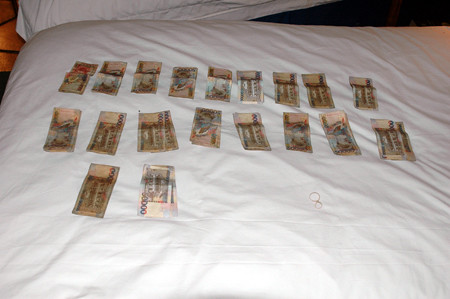 Drying dobras RCD GGIII
Drying dobras RCD GGIII 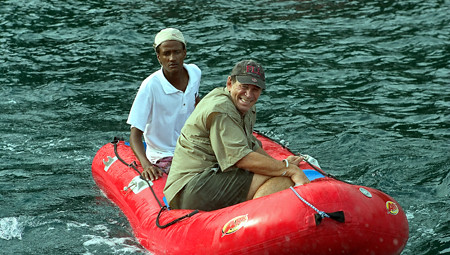 The offending boat, post-flipping. Weckerphoto GG III Anyway, once we finally found specimens of Rich’s Rotula, it was only natural that they become “sand dobras,” and the only beach we have found them on the west side of Sao Tome became Sand Dobra Beach-- its real name is Praia Morrão.
The offending boat, post-flipping. Weckerphoto GG III Anyway, once we finally found specimens of Rich’s Rotula, it was only natural that they become “sand dobras,” and the only beach we have found them on the west side of Sao Tome became Sand Dobra Beach-- its real name is Praia Morrão.  Rotula deciesdigitata on Sand Dobra Beach. D. Lin phot. GG II During GG II, Rich and I swam out beyond the surf line to try to secure a live specimen for DNA analysis (remember, the test you find on the beach is not the living animal, but rather its exoskeleton). The undertow was so powerful that we both nearly drowned, but we did find one specimen that retained a greenish color, suggesting that there might be some remaining tissue to analyze; the jury is still out on this. The sand dobras present a rather interesting mystery, in that they appear to be wholly unrelated to those of the New World, while such might not be the case with other echinoderms. In his own words, Rich says “this strange pattern is further underscored by the fact that as I looked at all the other echinoderms around Sao Tome, the faunas were nearly perfectly Caribbean in nature. There were times that I felt as though I was snorkeling around in Florida or Belize -- at least as far as the sea urchins were concerned. The rotulids were a glaring exception to that."
Rotula deciesdigitata on Sand Dobra Beach. D. Lin phot. GG II During GG II, Rich and I swam out beyond the surf line to try to secure a live specimen for DNA analysis (remember, the test you find on the beach is not the living animal, but rather its exoskeleton). The undertow was so powerful that we both nearly drowned, but we did find one specimen that retained a greenish color, suggesting that there might be some remaining tissue to analyze; the jury is still out on this. The sand dobras present a rather interesting mystery, in that they appear to be wholly unrelated to those of the New World, while such might not be the case with other echinoderms. In his own words, Rich says “this strange pattern is further underscored by the fact that as I looked at all the other echinoderms around Sao Tome, the faunas were nearly perfectly Caribbean in nature. There were times that I felt as though I was snorkeling around in Florida or Belize -- at least as far as the sea urchins were concerned. The rotulids were a glaring exception to that." 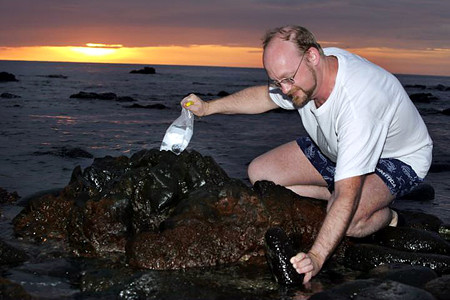 Rich working. D. Lin phot. GG II. Interestingly, there are many species with holes and notches in them throughout the Caribbean. These are almost all members of a sand dollar family known as the Mellitidae. However, there are absolutely no mellitids on the west coast of Africa. In fact, there are no "true" sand dollars at all. The truth is that the Gulf of Guinea sand dobras are not even closely related to the Caribbean sand dollars, but belong not only to a different family (Rotulidae), but to a completely different major clade (suborder). This is perplexing.
Rich working. D. Lin phot. GG II. Interestingly, there are many species with holes and notches in them throughout the Caribbean. These are almost all members of a sand dollar family known as the Mellitidae. However, there are absolutely no mellitids on the west coast of Africa. In fact, there are no "true" sand dollars at all. The truth is that the Gulf of Guinea sand dobras are not even closely related to the Caribbean sand dollars, but belong not only to a different family (Rotulidae), but to a completely different major clade (suborder). This is perplexing. 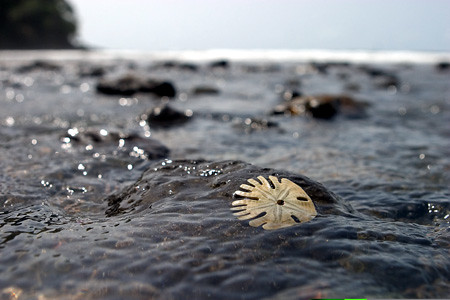 Rotula deciesdigitata on Sand Dobra Beach. Weckerphoto GG III Dr. Rich Mooi is still working on the many fascinating echinoderms he collected on the beaches and tidepools of São Tomé and Prìncipe in 2006, and I will report his discoveries as they appear.
Rotula deciesdigitata on Sand Dobra Beach. Weckerphoto GG III Dr. Rich Mooi is still working on the many fascinating echinoderms he collected on the beaches and tidepools of São Tomé and Prìncipe in 2006, and I will report his discoveries as they appear.
PARTNERS
We gratefully acknowledge the support of the Research Investment Fund of the California Academy of Sciences, the Société de Conservation et Développement (SCD) for logistics, ground transportation and lodging, STePUP of Sao Tome http://www.stepup.st/ and especially the generosity of three private individuals, George F. Breed, Gerry F. Ohrstrom and Timothy M. Muller, for making GG III possible.